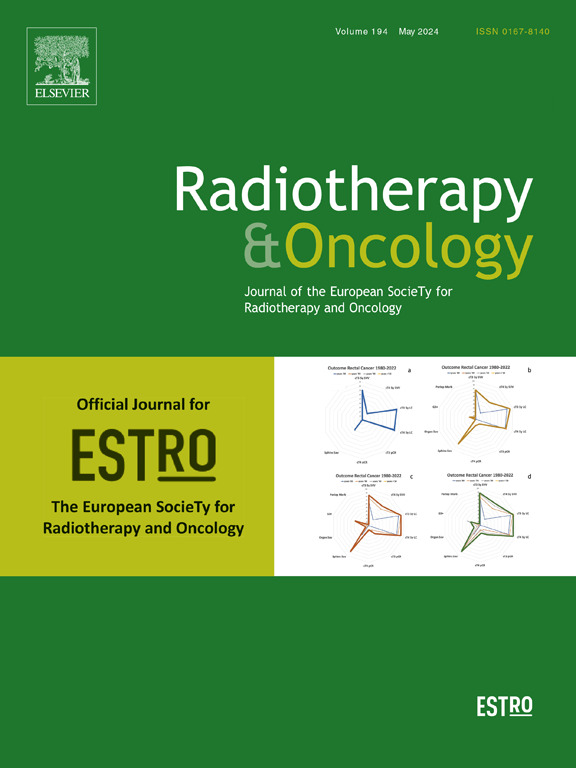质子治疗恶性脑肿瘤后患者报告的疲劳--辐射剂量与脑结构有关系吗?
IF 4.9
1区 医学
Q1 ONCOLOGY
引用次数: 0
摘要
背景:疲劳会严重影响放疗患者的日常生活和工作。一些研究表明,放射剂量和脑部照射量与疲劳的存在存在相关性。我们的假设是,患者报告的结果测量(PROMs)可以提高我们对质子束治疗(PBT)后患者症状的了解,并优化未来患者的质子束治疗:这项研究包括167名接受质子束疗法治疗恶性脑肿瘤的成年患者(18岁以上)。颅内结构的剂量指标数据来自 PBT 治疗计划。为了探究疲劳和健康相关生活质量(HRQoL),使用了多维疲劳量表(MFI-20)和 EORTC QLQ-C30,时间分别为 PBT 术后 6 个月、12-24 个月和 36 个月。采用斯皮尔曼符号秩检验探讨了疲劳与剂量测定之间的相关性:结果:在 36 个月的随访期间,没有发现严重的疲劳现象。结果:在 36 个月的随访期间,没有出现严重疲劳的记录,辐射剂量增加与疲劳评分恶化之间的相关性普遍较弱(rho 结论:质子束治疗的耐受性良好:质子束治疗的耐受性良好,PBT前后的疲劳程度相似。进一步降低平均脑剂量似乎是有益的。本文章由计算机程序翻译,如有差异,请以英文原文为准。
Patient reported fatigue after proton therapy for malignant brain tumours – Is there a relation between radiation dose and brain structures?
Background
Fatigue may significantly effect everyday- and working life for radiotherapy patients. Some studies indicate a correlation between radiation dose and irradiated volume of the brain and the presence of fatigue. Our hypothesis was that patient reported outcome measures (PROMs) can improve our understanding of the patients’ symptoms following proton beam therapy (PBT) and optimize PBT for future patients.
Methods
This study included 167 adult patients (>18 years) who received PBT for malignant brain tumours. Data on dose metrics to intra-cranial structures was obtained from PBT treatment plans. To explore fatigue and health related quality of life (HRQoL); Multidimensional Fatigue Inventory (MFI-20) and EORTC QLQ-C30 was used at 6-, 12-, 24- and 36 months post PBT. The correlation between fatigue and dosimetry was explored using Spearman’s signed rank test.
Results
No severe fatigue was recorded during the 36 months follow-up. Correlations between higher radiation dose and worsened fatigue scores were generally weak (rho < 0.3). At 12 months post PBT, higher mean dose to the brain, brainstem, hippocampi and pituitary was correlated to worsened MFI Physical Fatigue. Further, Reduced Motivation according to MFI was correlated to higher radiation dose to the brainstem and the pituitary gland. At 36 months follow-up post-PBT, both Reduced Activity and Reduced motivation according to MFI were correlated to higher radiation dose to the brain, brainstem and hippocampi.
Conclusion
Proton beam therapy are well tolerated, with similar degree of fatigue pre- and post PBT. Achieving further reduction in mean brain dose appears beneficial.
求助全文
通过发布文献求助,成功后即可免费获取论文全文。
去求助
来源期刊

Radiotherapy and Oncology
医学-核医学
CiteScore
10.30
自引率
10.50%
发文量
2445
审稿时长
45 days
期刊介绍:
Radiotherapy and Oncology publishes papers describing original research as well as review articles. It covers areas of interest relating to radiation oncology. This includes: clinical radiotherapy, combined modality treatment, translational studies, epidemiological outcomes, imaging, dosimetry, and radiation therapy planning, experimental work in radiobiology, chemobiology, hyperthermia and tumour biology, as well as data science in radiation oncology and physics aspects relevant to oncology.Papers on more general aspects of interest to the radiation oncologist including chemotherapy, surgery and immunology are also published.
 求助内容:
求助内容: 应助结果提醒方式:
应助结果提醒方式:


